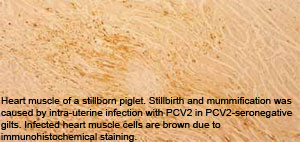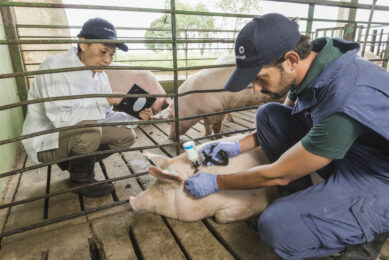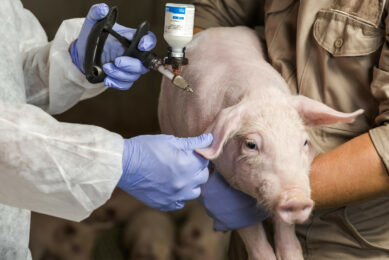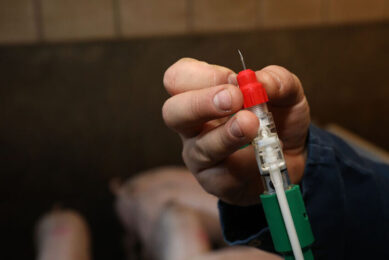Impact of PCV2 viraemia: Less virus, more profit

At the last edition of IPVS Congress in Vancouver, Canada, PCV2 virus received? much attention. The bottom line of a number of presentations was that a large variety of different influences may exert influence on pigs infected with PCV2, leading to death or reduced growth.
By Alex Eggen, DVM, Intervet/Schering-Plough Animal Health, Boxmeer, the Netherlands
PCV2 virus and its interaction with the immune system has been studied in great detail by several research groups from all over the world. There is general agreement that this very small virus has an impact on the immune system of the pig which mainly involves monocytes, macrophages and dendritic cells. This in turn leads to an ‘abnormal’ type of communication with other parts of the immune system. The body normally produces very small messenger molecules that inform other parts of the body that a pathogen has invaded and needs to be removed from the body. In the case of PCV2 virus infection, however, this mechanism does not function in its usual way. Instead, when PCV2 virus has entered the body, different messenger molecules are produced which inform the pig that everything is basically normal. This wrong information induced by the PCV2 virus is the basis of the problem of understanding its complexities.
The immune system
In normal situations, when a viral infection occurs, both humoral (antibodies) and cellular (white blood cells) immunity are mobilised against the invading virus. The same occurs during a PCV2 virus infection, but remarkable differences can be seen in the interaction with the immune system. PCV2 strains are very slow to induce the relevant levels of virus neutralising antibodies, and it has been shown that lower levels of virus neutralising antibodies are more often observed in PMWS-affected pigs. In addition, it has been reported that the PCV2 viral load was reduced when virus neutralising antibodies and PCV2-specific cellular responses were recorded. In other words, piglets can react to a natural PCV2 infection in immunologically different ways. It is unknown how these differences occur. It is clear, however, from the literature that PCV2 virus interacts with the immune system with clear consequences and that the virus, therefore, needs to be controlled to avoid any possible negative effect on production parameters.
The virus
Viruses invade the body of the pig and disappear after a certain time. In the case of PCV2 the virus can persist in certain cells for months, without effective replication and without killing the cell. These cells, dendritic cells and macrophages, are immunologically important, but when they harbour PCV2 virus their functionality is impaired. The fine tuning in the immune system which is necessary to fight PCV2 virus (and other invading pathogens) does not work properly. This phenomenon is best illustrated by one of the remarkable features seen in the field after the introduction of PCV2 vaccines. It is characterised by a significant reduction in the medication needed to combat all kinds of concurrent diseases after PCV2 vaccination compared with the period beforehand.
Breaking through MDA’s
Complicating the field situation, however, is the Maternally Derived Antibody (MDA) titre. This factor influences both the complete picture of PCV2-related diseases and vaccination take. Further complicating the issue is an enormous variation in antibody titre against PCV2 virus, found within any batch of piglets from the same farrowing unit.
The right level of MDA is extremely important to successfully deal with a PCV2 infection. Last year, Dr Maria Fort, from CReSA, Spain, reported that a certain level of MDA is required to neutralise the virus effectively, and a piglet with an antibody titre below that level will experience viraemia when challenged. She also reported that MDA in excess ofa certain titre will have a negative influence on vaccination take, when sero-conversion is regarded as a measure of vaccination take.
Findings like these explain why in field conditions, a spectrum of different protection levels can exist, from piglets perfectly protected by MDA (sometimes for up to 12 weeks of age) to piglets that are basically susceptible to infection within days of birth (see Figure 1). But there are conditions, for example following a recent PCV2 virus infection or when breeding stock have been vaccinated, which can lead to uniformly high titres in the piglets. These high titres are protective but can also interfere with vaccination. In these conditions, an early PCV2 infection may cause no harm to the piglets at all, due to high levels of MDA and disease occurs when immunity provided by the MDA’s declines over time. The interaction between MDA, vaccination and field challenge can further be complicated by other factors including concurrent infections, PCV2 strain and field challenge load, genetics etc.
Influence of MDA titre
Dr Andreas Palzer, Clinic for Swine of the LMU Munich, reported a field trial in which piglets were vaccinated with a single dose of 2 ml of PCV2 vaccine (Porcilis PCV, Intervet/Schering-Plough Animal Health) either during the first week of life or at three weeks of age. Since MDA levels decline naturally over time, the pigs vaccinated at three weeks of age have lower MDA levels than those vaccinated earlier. The two groups were kept under exactly the same conditions, but they both exhibited different serological profiles and performed differently.
The group vaccinated at three weeks (lower MDA levels) responded better to the vaccine, producing higher antibody titres when challenged. This group also performed significantly better in Average Daily Gain (ADG) by 27 g/day. The group vaccinated in the first week of life performed better than the unvaccinated controls, showing that even in the presence of high levels of MDA, vaccination can still be worthwhile (see Figure 2). Palzer’s trial showed that despite different MDA levels at vaccination at three weeks of age, the use of the vaccine leads to uniform antibody titres. Vaccinating at three weeks of age clearly yielded a higher return-on-investment (ROI). Both the control group and the group vaccinated in the first week of life had higher PCV2 viral loads than the group vaccinated at three weeks of age, emphasising again that viraemia matters and that less virus means more profit.
Heavier weight
Another study providing an example of the influence of PCV2 viral load was presented by Dr Kwang-Soo Lyoo, University of Minnesota, USA and is the subject of a full article in the Veterinary Journal. Its authors reported that light weight pigs at slaughter carried more PCV2 virus than the heavier pigs. They also reported finding more PCV2b than PCV2a in the light weight pigs, another indication of strain differences. In their discussion, the authors mention that there may still be negative effects on production from PCV2 infection even of vaccinated pigs, and that vaccination timing may need to be adjusted to protect pigs from PCV2 infection until late in the finishing phase. The observation that PCV2 virus can have a negative effect on performance even in vaccinated pigs was studied in detail by the University of Guelph and reported by Dr Cate Dewey, see Figure 3.
Less virus, more profit
PCV2 virus has very distinct characteristics and still features of this virus remain obscure. Partial protection provides some benefit in performance over unvaccinated controls, but better control of PCV2 virus leads to even better results. The better PCV2 virus is controlled, the better the economics.











